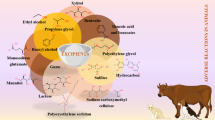Abstract
Drugs have been compounded for veterinary practice for many years because it has been necessary in the course of routine practice. However, regulations and compliance policy guidelines (CPGs) should be recognized. A new CPG issued in July 2003 listed the current Food and Drug Administration (FDA) limitations on compounding for veterinary medicine. To summarize the guideline: drugs must not be compounded from bulk substances, and the compounding must not constitute, manufacture of a new animal drug. Drug compounding on a case-by-case basis is allowed under the CPG. However, veterinarians and pharmacists must be aware of potential incompatibilities and practices that may interfere with the drug's stability, purity, and/or potency.
Similar content being viewed by others

References
United States Pharmacopeial Convention. Good compounding practices. In:The United States Pharmacopeia and the National Formulary, USP 28, NF 23. Rockville, MD: United States Pharmacopeial Convention, Inc; 2005:2620–2457.
FDA-CVM. FDA/CVM's Compliance policy guide on compounding of drugs.J. Am Vet Med Assoc. 1996;209:2025–2029.
Symposium on Compounding in Veterinary Medicine.J Am Vet Med Assoc. 1993;205:189–303.
FDA-CVM. Food and Drug Administration Web site. Compounding of Drugs for Use in Animals. Compliance Policy Guide: Compliance Policy Guidance for FDA Staff and Industry. Ch 6, sub ch 600, §608.400. Available at: http://www.fda.gov/cvm/index/updates/compound.htm. Accessed July 2003.
JAVMA. Animal drugs seized.J Am Vet Med Assoc. 1999;214:21.
Davis J. Compounding for creatures: what works.Int J Pharm Comp. 1999;3:182–187.
Graham JP, Lipman AH, Newell SM, Roberts GD. Esophageal transit of capsules in clinically normal cats.Am J Vet Res. 2000;61:655–657.
Westfall DS, Twedt DC, Steyn PF., Oberhauser EB, VanCleave JW. Evaluation of esophageal transit of tablets and capsules in 30 cats.J Vet Intern Med. 2001;15:467–470.
Carlborg B, Densert O. Esophageal lesions caused by orally administered drugs: an experimental study in the cat.Eur Surg Res. 1980;12:270–282.
Carlborg B, Densert O, Lindqvist C. Tetracycline induced esophagcal ulcers: a clinical and experimental study.Laryngoscope. 1983;93:184–187.
United States Pharmacopeial Convention. Stability considerations in dispensing practice. In:The United States Pharmacopeia and the National Formulary, USP 28, NF 23. Rockville, MD: United States Pharmacopeial Convention, Inc; 2005:2727–2730.
Nieto JE, Spier S, Pipers FS, et al., Comparison of paste and suspension formulations of omeprazole in the healing of gastric ulcers in racehorses in active training.J Am Vet Med Assoc, 2002;221:1139–1143.
Grass GM, Sinko PJ. Physiologically-based pharmacokinetic simulation modelling.Adv Drug Deliv Rev. 2002;54:433–451.
Martinez M, Amidon G, Clarke L, Jones WW, Mitra A, Riviere J. Applying the biopharmaceutics classification system to veterinary pharmaceutical products. Part II. Physiological considerations.Adv Drug Deliv Rev. 2002;54:825–850.
Martinez M, Augsburger L, Johnston T, Jones WW. Applying the biopharmaceutics classification system to veterinary pharmaceutical products. Part I. Biopharmaceutics and formulation considerations.Adv Drug Deliv Rev. 2002:54:805–824.
Amidon GL, Lennernas H, Shah VP, Crison JR. A theoretical basis for a biopharmaceutics drug classification: the correlation ofin vitro drug product dissolution andin vivo bioavailability.Pharm Res. 1995;12:413–420.
Kararli TT. Comparison of the gastrointestinal anatomy, physiology, and biochemistry of humans and commonly used laboratory animals.Biopharm Drug Dispos. 1995;16:351–380.
Dressman JB. Comparison of canine and human gastrointestinal physiology.Pharm Res. 1986;3:123–131.
Lin JH. Species similarities and differences in pharmacokinetics.Drug Metab Dispos. 1995;23:1008–1021.
Chiou WL, Jeong HY, Chung SM, Wu TC. Evaluation of using dog as an animal model to study the fraction of oral dose absorbed of 43 drugs in humans.Pharm Res. 2000;17:135–140.
Sabnis S. Factors influencing the bioavailability of peroral formulations of drugs for dogs.Vet Res Commun. 1999;23:425–447.
Lee DD, Papich MG, Hardie EM. Comparison of pharmacokinetics of fentanyl after intravenous and transdermal administration in cats.Am J Vet Res. 2000;61:672–677.
Kyles AE, Papich MG, Hardie EM. Disposition of transdermally administered fentanyl in dogs.Am J Vet Res. 1996;57:715–719.
Kyles AE, Hardie EM, Hansen BD, Papich MG Comparison of transdermal fentanyl and intramuscular oxymorphone on post-operative behaviour after ovariohysterectomy in dogs.Res Vet Sci. 1998;65:245–251.
Riviere JE, Papich MG. Potential, and problems of developing transdermal patches for veterinary applications.Adv Drug Deliv Rev. 2001;50:175–203.
Nolan TR, Davidson G, Webster K, Pharmacokinetics of transdermal diltiazem in cats [abstract 25]. Paper presented at: North Carolina State Research Forum; May 2002; North Carolina State University, Raleigh, NC.
Hoffman SB, Yoder AR, Trepanier LA. Bioavailability of transdermal methimazole in a pluronic lecithin organogel (PLO) in healthy cats.J Vet Pharmacol Therap. 2002;25:189–193.
Bennett N, Papich MG, Hoenig M, Fettman MJ, Lappin MR. Evaluation of transdermal application of glipizide in a pluronic lecithin gel to healthy cats.Am J Vet Res. 2005;66:581–588.
Ciribassi J, Luescher A, Pasloske KS, Robertson-Plouch C, Zimmerman A, Kaloostian-Whittymore L. Comparative bioavailability of fluoxetine after transdermal and oral administration to healthy cats.Am J Vet Res. 2003;64:994–998.
Trepanier LA. Transdermal formulations: which ones are effective? ACVIM Annual Forum Proceedings; June 2002; American College of Veterinary Medicine. 463–464.
Sartor LL, Trepanier LA, Kroll MM, Rodan I, Challoner L. Efficacy and safety of transdermal methimazole in the treatment of cats with hyperthyroidism.J Vet Intern Med. 2004.18(5):651–655.
Hoffman G, Marks SL, Taboada J, et al. Topical methimazole treatment of cats with hyperthyroidism.J Vet Intern Med. 2001;15:299.
Mealey KL, Peck KE, Bennett BS, et al. Systemic absorption of amitriptyline and buspirone after oral and transdermal administration to healthy cats.J Vet Intern Med. 2004; 18(1):43–46.
Willis-Goulet HS, Schmidt BA, Nicklin CF, et al. Comparison of serum dexamethasone concentrations in cats after oral or transdermal administration using pluronic lecithin organogel (PLO): a pilot study.Vet Dermatol. 2003;14:83–89.
United States Pharmacopeial Convention. Pharmaceutical compounding. In: The United States Pharmacopeia and the National Formulary, USP 28, NF 23. Rockville, MD: United States Pharmacopeial Convention Inc; 2005:<795>, <797>,<1075>.
Author information
Authors and Affiliations
Corresponding author
Additional information
Published: September 22, 2005.
Rights and permissions
About this article
Cite this article
Papich, M.G. Drug compounding for veterinary patients. AAPS J 7, 29 (2005). https://doi.org/10.1208/aapsj070229
Received:
Accepted:
DOI: https://doi.org/10.1208/aapsj070229



